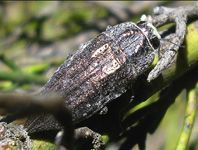Abstract
A relatively less known assassin bug, Rhaphidosoma atkinsoni Bergroth, 1893 (Hemiptera: Heteroptera: Reduviidae: Harpactorinae) is recorded from Maharashtra State, India, for the first time. Redescription and illustrations of the species, along with the notes on morphology and natural history, are provided.
References
Ambrose, D.P. (2006) A checklist of Indian assassin bugs (Insects: Heteroptera: Reduviidae) with taxonomic status, distribution and diagnostic morphological characteristics. Zoos’ Print Journal, 21 (9), 2388–2406.
https://doi.org/10.11609/JoTT.ZPJ.871.2388-406Bérenger, J.M. & Pluot-Sigwalt, D. (1997) Special relationship of certain predatory Heteroptera Reduviidae with plants. First known case of a phytophagous Harpactorinae. Academie des Sciences (Animal Biology), 320, 1007–1012.
Bergroth, E. (1893) Description of some Rhynchota of geographical interest. Entomologist’s Monthly Magazine, 29, 61–63.
Biswas, B. & Mitra, B. (2014) Checklist of Indian assassin bugs (Insecta: Hemiptera: Reduviidae). Available from: http://indiabiodiversity.org/document/show/302?pos= (accessed 7 March 2017)
Distant, W.L. (1904) The Fauna of British India, including Ceylon and Burma. Rhynchota – (Heteroptera) 2. Taylor and Francis, London, 503 pp.
Distant, W.L. (1906) LIII Oriental Reduviidae. The Annals and Magazine of Natural History, Series 7, 18, 363 –370.
Forero, D. (2011) Classification of Harpactorinae assassin bugs (Hemiptera: Heteroptera: Reduviidae). Boletin del Museo Entomológico, 3 (1), 9–24.
Gessé, F. & Goula, M. (2006) Checklist of terrestrial bugs (Insecta, Hemiptera, Heteroptera) from Garraf Massif (Catalonia). Boletín de la Asociación Española de Entomología, 30 (3–4), 51–74.
Ghahari, H., Moulet, P., Cai, W. & Karimi, J. (2013) An annotated catalog of the Iranian Reduvioidea (Hemiptera: Heteroptera: Cimicomorpha). Zootaxa, 3718 (3), 201–238.
https://doi.org/10.11646/zootaxa.3718.3.1Goula, M., Ribes, J. & Serra, A. (2010) Checklist of Heteroptera of Catalonia (Insecta, Hemiptera, Heteroptera). Version 1. June 2010. Centre de Recursos de Biodiversitat Animal, Facultat de Biologia, Universitat de Barcelona, Barcelona, 38 pp.
Haridass, E.T. (1985) Feeding and ovipositional behaviour of some reduviids (Heteroptera: Reduviidae). Proceedings of the Indian Academy of Science (Animal Science), 94 (3), 239–247.
https://doi.org/10.1007/BF03186266Haridass, E.T. (1988) Ultrastructure of eggs of Reduviidae: IV. Eggs of Rhaphidosomatinae (Insecta–Heteroptera). Proceedings of the Indian Academy of Science (Animal Science), 97 (1), 49–54.
https://doi.org/10.1007/BF03179510Kerzhner, I.M. (1992) Nomenclatural and bibliographic corrections to J. Maldonado Capriles (1990) “Systematic Catalogue of the Reduviidae of the World (Insecta: Heteroptera). Zoosystematica Rossica, 1, 46–60.
Kulkarni, S. & Ghate, H.V. (2016) A new cavernicolous assassin bug of the genus Bagauda Bergroth (Heteroptera: Rduviidae: Emesinae) from the Western Ghats, India. Zootaxa, 4127 (2), 365–375.
http://dx.doi.org/10.11646/zootaxa.4127.2.8Maldonado Capriles, J. (1990) Systematic catalogue of the Reduviidae of the world. In: Caribbean Journal of Science. Special Edition. University of Puerto Rico, Mayagüez, pp. 1–694.
Miller, N.C.E. (1953) Notes on the biology of the Reduviidae of Southern Rhodesia. Transactions of Zoological Society, 27 (6), 541–672.
https://doi.org/10.1111/j.1096-3642.1953.tb00233.xMiller, N.C.E. (1956) The biology of the Heteroptera. Leonard Hill, London, 162 pp.
Mukherjee, P. & Hassan, M.E. (2016) Some new records of Reduviidae from Telangana, India (Hemiptera: Heteroptera). Munis Entomology & Zoology, 11 (2), 591–595.
Ponel, P., Matocq, A. & Médail, F. (2015) Hétéroptères nouveaux ou remarquables pour la Tunisie (Heteroptera: Alydidae, Reduviidae et Saldidae). L’Entomologiste, 6, 369–376.
Schuh, R.T. & Slater, J.A. (1995) True bugs of the world (Hemiptera: Heteroptera) – Classification and natural history. Cornell University Press, Ithaca, 336 pp.
Sharma, R.M. & Bano, R. (2012) Insecta: Hemiptera: Reduviidae (assassin bugs). In: Fauna of Maharashtra. Part 2. Zoological Survey of India, Kolkata, pp. 477–478.
Sheth, S. & Ghate, H.V. (2014) A report of an aquatic beetle Eretes griseus (Fabricius, 1781) (Coleoptera: Dytiscidae: Dytiscinae: Eretini) from the Western Ghats and other parts of Maharashtra, India. Journal of Threatened Taxa, 6 (12), 6571–6575.
https://doi.org/10.11609/JoTT.o4036.6571-5Villiers, A. (1948) Hémiptères Réduviidés de l’Afrique Noir. Faune de l’Empire Français IX. Office de la Recherche Scientifique Coloniale, Paris, France, 488 pp.
Weirauch, C. (2008) Cladistic analysis of Reduviidae (Heteroptera: Cimicomorpha) based on morphological characters. Systematic Entomology, 33, 229–274.
https://doi.org/10.1111/j.1365-3113.2007.00417.xWeirauch, C. & Munro, J.B. (2009) Molecular phylogeny of the assassin bugs (Hemiptera: Reduviidae) based on mitochondrial and nuclear ribosomal genes. Molecular Phylogenetics and Evolution, 53, 287–299.
https://doi.org/10.1016/j.ympev.2009.05.039Zhang, J., Weirauch, C., Zhang, G. & Forero, D. (2015) Molecular phylogeny of Harpactorinae and Bactrodinae uncovers complex evolution of sticky trap predation in assassin bugs (Heteroptera: Reduviidae). Cladistics, 32 (5), 538–554.
https://doi.org/10.1111/cla.12140

